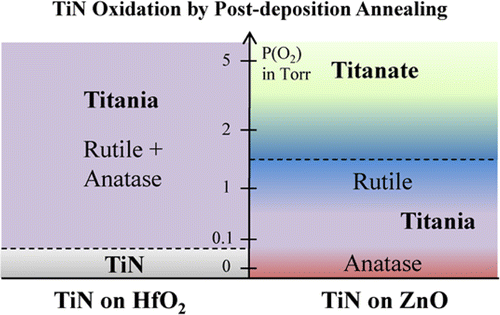当前位置:
X-MOL 学术
›
J. Phys. Chem. C
›
论文详情
Our official English website, www.x-mol.net, welcomes your
feedback! (Note: you will need to create a separate account there.)
Observation of Titania and Titanate Phase Changes in Oxidation-Controlled ZnO/TiN and HfO2/TiN Thin Films: An X-ray Absorption Spectroscopy Study
The Journal of Physical Chemistry C ( IF 3.3 ) Pub Date : 2016-08-16 00:00:00 , DOI: 10.1021/acs.jpcc.6b06565 Doyeong Kim 1 , Minji Lee 1 , Seung-Yub Song 1 , Dae Hyun Kim , Tae Joo Park , Deok-Yong Cho 1
The Journal of Physical Chemistry C ( IF 3.3 ) Pub Date : 2016-08-16 00:00:00 , DOI: 10.1021/acs.jpcc.6b06565 Doyeong Kim 1 , Minji Lee 1 , Seung-Yub Song 1 , Dae Hyun Kim , Tae Joo Park , Deok-Yong Cho 1
Affiliation

|
We investigated the local electronic structures of oxidation-controlled TiN thin films for preparation of photocatalytic titania using soft X-ray absorption spectroscopy. It is shown that the TiN layers on top of oxides, such as HfO2 or ZnO, are easily oxidized by heat during postdeposition annealing (PDA) so as to form nitrogen-incorporated titania (N-TiO2). The local structures of the oxidized films evolved significantly depending on the bottom oxide and the PDA conditions; when TiN was deposited on HfO2, which is less reactive than ZnO, PDA at 700 °C stabilized a mixture of rutile and anatase phases under almost any gas (N2 or O2) environments. On the other hand, when TiN was deposited on ZnO, which is reactive enough to oxidize the TiN layers substantially, the PDA resulted in a rich phase diagram according to the gas environment: under N2 environment, an anatase local structure is dominant, whereas under O2 environment, a rutile or yet another local structure with a high symmetry, for example, perovskite or ilmenite ZnTiO3, becomes dominant. As for the origin of the phase changes, the abundance of the oxide phases is found to be strongly correlated with the averaged grain sizes in the films. The changes in the local structures resulted in the blue- or red-shifts of conduction band, implying that we can engineer the electronic properties in the N-TiO2 films by properly choosing the bottom oxide.
中文翻译:

氧化控制的ZnO / TiN和HfO 2 / TiN薄膜中二氧化钛和钛酸酯相变的观察:X射线吸收光谱研究
我们研究了使用软X射线吸收光谱法研究氧化控制TiN薄膜用于制备光催化二氧化钛的局部电子结构。结果表明,在沉积后退火(PDA)期间,氧化物(如HfO 2或ZnO)上的TiN层容易被热氧化,从而形成掺氮的二氧化钛(N-TiO 2)。氧化膜的局部结构取决于底部氧化物和PDA条件而显着变化。当TiN沉积在HfO 2上,而HfO 2的反应性不如ZnO时,PDA在700°C的温度下几乎可以在任何气体(N 2或O 2)下稳定金红石相和锐钛矿相的混合物。)环境。另一方面,当TiN沉积在ZnO上时,其反应性足以充分氧化TiN层,因此PDA根据气体环境生成了丰富的相图:在N 2环境下,锐钛矿局部结构占主导地位,而N 2在O 2环境下,具有高对称性的金红石或其他局部结构(例如钙钛矿或钛铁矿ZnTiO 3)成为主导。至于相变的起因,发现氧化物相的丰度与膜中平均晶粒尺寸密切相关。局部结构的变化导致导带发生蓝移或红移,这意味着我们可以设计N-TiO 2中的电子性质 通过适当地选择底部氧化物膜。
更新日期:2016-08-16
中文翻译:

氧化控制的ZnO / TiN和HfO 2 / TiN薄膜中二氧化钛和钛酸酯相变的观察:X射线吸收光谱研究
我们研究了使用软X射线吸收光谱法研究氧化控制TiN薄膜用于制备光催化二氧化钛的局部电子结构。结果表明,在沉积后退火(PDA)期间,氧化物(如HfO 2或ZnO)上的TiN层容易被热氧化,从而形成掺氮的二氧化钛(N-TiO 2)。氧化膜的局部结构取决于底部氧化物和PDA条件而显着变化。当TiN沉积在HfO 2上,而HfO 2的反应性不如ZnO时,PDA在700°C的温度下几乎可以在任何气体(N 2或O 2)下稳定金红石相和锐钛矿相的混合物。)环境。另一方面,当TiN沉积在ZnO上时,其反应性足以充分氧化TiN层,因此PDA根据气体环境生成了丰富的相图:在N 2环境下,锐钛矿局部结构占主导地位,而N 2在O 2环境下,具有高对称性的金红石或其他局部结构(例如钙钛矿或钛铁矿ZnTiO 3)成为主导。至于相变的起因,发现氧化物相的丰度与膜中平均晶粒尺寸密切相关。局部结构的变化导致导带发生蓝移或红移,这意味着我们可以设计N-TiO 2中的电子性质 通过适当地选择底部氧化物膜。


















































 京公网安备 11010802027423号
京公网安备 11010802027423号